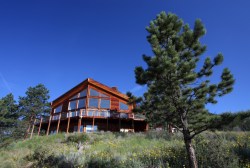
How the rich live in Aspen.
The exclusive resort town of Aspen, Colo., has an international reputation for high-end service and a stunning landscape of pristine mountains, all configured to welcome wealthy tourists. Like many communities in the U.S., Aspen depends on low-wage immigrant labor to fuel its service economy. Also like many communities in the U.S., Aspen passed a resolution calling on the federal government to restrict both documented and undocumented immigration in order to preserve the economic and cultural integrity of the nation.
But Aspen’s resolution, passed unanimously by the city council in 1999, was different from many others around the country in that it played up environmental concerns as well, providing green cover for the demonization of low-income immigrants from Latin America.
Shortly after its passage, city council member Terry Paulson — a longtime immigration critic and self-avowed environmentalist — announced that he would be working on a statewide campaign to “promote overpopulation awareness” and declared, “If we address population and do something about it, everything else will fall in line.”
When we traveled to the area, we found two very different Aspens. The dominant, commercial Aspen was an idyllic, post-industrial refuge with stretch Range Rover limousines, toy poodles with diamond-encrusted collars, world-class ski slopes, and Hollywood celebrities who spend just a few weeks a year in multimillion-dollar single-family homes.

How immigrants live outside of Aspen. (Photo by Brent Gardner-Smith/Aspen Journalism)
The other Aspen is a place where foreign-born laborers from Latin America work in low-status, often dangerous, jobs for low wages with few benefits. In some cases, they drive 60 to 140 miles round-trip daily to get to those jobs because they can’t afford to live near Aspen’s core. Many of these workers live in deplorable housing conditions, including campers and cars “down valley” in trailer parks along the highway in dangerous flood zones.
Aspen’s goal is to be a “city beautiful,” a beacon of sustainability. Unfortunately, its path toward that goal has been paved with nativism and exclusion. The town’s resolution reflects the longstanding link between nativism and environmentalism in the U.S. As Aspen council member Tom McCabe cautioned, “The planet’s a finite resource … We can’t indefinitely welcome people and expect to maintain our quality of life.”
And this is precisely the point: Many Aspenites and others in similarly privileged communities across the U.S. want to protect their quality of life, which requires resources and wealth derived from ecosystems and labor from around the world.
While the city council put the blame on immigrants, Aspen has continued to allow construction of rarely inhabited vacation homes made of materials from across the globe, requiring year-round maintenance and energy usage. One local who looked after homes while absentee owners were out of town told a journalist that most of the properties he managed were empty 45 weeks of the year. “Yet they had to stay heated so the pipes wouldn’t freeze and their swimming pools, as a rule, were heated continuously — not drained — so they’d be ready for use when the owners arrived.” One Aspen resident and multimillionaire financier dug up and hauled away an entire hillside so that he could more easily “keep an eye on his horses.” He thought this was perfectly reasonable for his new “cabin” — a 7,500-square-foot luxury home that sits on a 157-acre lot.
So who is actually causing the most environmental harm?

Read the authors’ book, The Slums of Aspen.
For more than three decades, scholars have presented evidence that low-income, immigrant, and minority communities face greater threats from environmental problems than other groups. While these studies reveal the hardships associated with environmental inequality, fewer studies consider the flip side of that reality: environmental privilege. Environmental privilege results from the exercise of economic, political, and cultural power, enabling some groups to enjoy near-exclusive access to coveted environmental amenities such as parks, mountains, and open lands. Environmental privileges accrue to the few while environmental burdens confront the many.
We have a more optimistic vision for the future, arrived at after talking with immigrant workers about their hopes and dreams for the community, and after learning about the work being done by local citizen-activists. We came away from that beautiful place with a belief that we can equitably care for both ecosystems and humankind, creating a society where social and environmental justice, inclusivity, and democracy can all thrive.
Also check out:
- Stephen Colbert mocks group that blames immigrants for climate change
- Is the environmental crisis caused by the 7 billion or the 1%?



